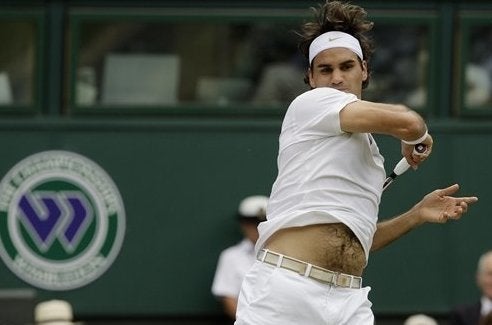
 Just watching Nadal and Federer pound forehands and backhands for nearly 5 hours during Sunday's Wimbledon final made my elbow hurt! It is a testament to the physical shape that they are in that they were able to hit the ball as hard and with as much accuracy at 9pm as they did when the match started hours earlier. Unfortunately, for most of us, overuse of a particular body part often results in pain or injury. Tennis elbow or lateral epicondylitis, the term doctors use to describe the condition, is a perfect example of an overuse type of injury.
Just watching Nadal and Federer pound forehands and backhands for nearly 5 hours during Sunday's Wimbledon final made my elbow hurt! It is a testament to the physical shape that they are in that they were able to hit the ball as hard and with as much accuracy at 9pm as they did when the match started hours earlier. Unfortunately, for most of us, overuse of a particular body part often results in pain or injury. Tennis elbow or lateral epicondylitis, the term doctors use to describe the condition, is a perfect example of an overuse type of injury.
Tennis elbow is a common cause of lateral-sided (thumb-sided or away from the body) elbow pain. Though the condition often affects tennis players, usually on their backhand shots or volleys, anyone can get it. According to David Dines MD, a sports medicine specialist at The Hospital for Special Surgery and Medical Director for the Association of Tennis Professionals (ATP) Tour, "Any repetitive motion that involves extending the wrist/supinating the forearm ....gardening, carpentry, even carrying a heavy briefcase..... can cause the symptoms." Typically it affects adults in their 30's to 50's in their dominant arm. The pain is localized to the lateral aspect of the elbow, and is worsened with resisted wrist extension or supination.
Interestingly, despite the fact that the name lateral epicondylitis implies that this condition is a tendonitis; it is more accurately a tendonosis. Either way, tennis elbow involves the extensor tendons that originate at the elbow, and it begins with microtears of these tendons. Eventually these tears can progress to larger tears.
The majority of cases respond well to conservative treatment of which activity modification and rest are the mainstays. Other options include anti-inflammatory medications, wrist splinting, forearm bracing, and physical therapy.
More invasive options include steroid injections and shock wave therapy. In a review of 9 studies that used shock wave therapy in more than 1000 patients, there was minimal benefit compared to placebo. Steroid injections are not without risks, but several studies have shown them to be of some benefit. The main advantage of such injections is seen in the short term. In a study in Lancet Journal, patients who received steroid injections showed the most improvement at the 6-week mark. At the one year mark, however, the group that had physical therapy did the best. Skin depigmentation and tendon rupture have been reported after steroid injection. More recently, some authors have begun studying the effects of platelet rich plasma on epicondylitis. This procedure involves taking blood from the patient and spinning it on a centrifuge to isolate the factors in the blood that have the most healing potential. This isolate is then injected into the site of tendonosis. Initial studies are promising, but larger studies with longer follow up are necessary before this becomes a mainstay of treatment.
According to Dines, "Most patients are typically treated with a combination of non-operative modalities, and the success rate is about 80%. However, there are a percentage of patients that do not respond and may need surgery." Typically this is reserved for patients who have failed non-operative management for more than a year. Surgery is more likely to be successful in patients with localized pain that affects their activities of daily living and who had a good initial response to injection.
Surgical treatment has progressed from large incisions over the lateral aspect of the elbow to smaller incisions, with some cases even being done arthroscopically. Very soon after surgery, patients begin range of motion exercises. They progress to strengthening at 6 weeks and typically return to sport at about 3 months after surgery.
Obviously the best treatment is prevention. So, as inspiring as it is to watch Nadal or Federer or Roddick crush balls for hours, us weekend warriors should build up gradually, taking care to always warm up and cool down appropriately!
--
For more information about sports medicine, visit the Joe DiMaggio Sports Medicine Center.
Mission statement: Manhattan's Joe DiMaggio Sports Medicine Center is devoted to rendering the very best non-surgical foot and ankle care, specializing in effective, non-intrusive methods as a primary objective. At the same time, the Center is affiliated with the world renowned Hospital for Special Surgery (HSS), affording traditional surgical and other options. The HSS, located in New York, has been recently rated the Number One hospital in the country for orthopedics by the US News and World Report. The Center also offers the expertise of orthopedic surgical and non-surgical clinicians in all areas of care.
The Center is named after American sports icon Joe DiMaggio, whose heel spur disability remains one of the most well-known sports injuries in history.